Topics
Category
Era
Southdale Center
Donald Dayton, head of Minneapolis-based Dayton's department stores, once commissioned a study that reinforced what most Minnesotans have experienced firsthand: the state has only 126 "ideal shopping weather" days each year. Rather than give up and relocate to more temperate climes, Dayton took action and teamed up with designer Victor Gruen to create a comfortable, convenient setting for Minnesota shoppers. In 1952 Dayton and Gruen unveiled their plans for Southdale, the nation's first enclosed, weatherproofed mall.
Gruen's aspirations went far beyond retail bliss. A Jewish Viennese citizen who had escaped his homeland during the Nazi takeover, Gruen hoped to create a new kind of American community inspired by the best of European urban life. The Dayton Corporation bought 500 acres of land in Edina, and Gruen drew up plans that placed the mall at the core of a new development of apartment buildings, houses, schools, a medical center, a park, and a lake. Gruen's vision was, as one writer later described, "the Minneapolis downtown you would get if you started over and corrected all the mistakes that were made the first time around."
Southdale Center was built at a cost of $20 million and had eighty thousand square feet; it opened with seventy-two stores and two anchors, Dayton's and Donaldson's. Seventy-five thousand people attended the gala opening on October 8, 1956. Another 188,000 visited the complex the following weekend, most taking advantage of the mall's five thousand free parking spaces (organized into lots identified by clever animal symbols—an innovation, like the mall itself, that would inspire countless imitators). What did visitors see? Gruen's interpretation of the best of European cities: "streets," cafes, two department stores, and many smaller boutiques surrounding a "town square" with a garden court spotlighted by an enormous skylight. A fishpond, mature trees, and a twenty-one-foot cage filled with brightly colored birds. In short, a prototype for the malls that would fuel suburban growth throughout the country.
What of the rest of Gruen's vision? The medical center opened in 1965; eventually, the Corporation sold the remaining land for housing. With his dreams only partially realized, Gruen eventually came to detest shopping malls, decrying the suburban sprawl often associated with them. Love them or hate them, though, there's no denying their impact on American life. Southdale changed more than shopping habits; it led to the transformation of the American landscape.
From Southdale's 1956 press release:
"Southdale shopping center could be called in psychological terms 'an introvert center.' On the outside it presents a quiet and dignified appearance, inviting the shopper to enter through one of ten huge all-glass entrances into the interior. . . . Here he finds himself in an atmosphere of unparalleled liveliness, colorfulness, and beauty. Between shopping activities there is an opportunity for rest in the sidewalk cafe and on the many rest benches. Here is a chance to amble and promenade, to window shop, to chat with friends, and a large array of features arouses interest and invites contemplation. Trees, tropical plants, flowers, a bird cage, sculptures, and other work of important artists, a pond, a fountain, a juice bar, a cigar and newsstand are some of them."
Bibliography
Edgerton, Martin. "From Southdale to the Mall of America : Urban Models for Cities of Our Time." Hennepin History 51, no. 3 (1992): 4–14.
Gladwell, Malcom. "The Terrazzo Jungle." New Yorker, March 15, 2004.
Southdale Regional Shopping Center. N.p.: [Minnesota: 196?].
Related Resources
Primary
Adolph F. Meyer papers, 1901–1971
Manuscript Collection, Minnesota Historical Society, St. Paul
http://www2.mnhs.org/library/findaids/00065.xml
Descriptions: Project files and related papers of a hydraulic engineer and inventor who for many years maintained a consulting practice in Minneapolis (Minn.). The files include correspondence and memoranda, notes and calculations, project reports, maps, mechanical drawings, photographs, and hydrological, meteorological, and other data.
Etnier, Ralph J. Natural gas operates world's largest heat pump. Minneapolis, Minn.: Minneapolis Gas Company, Suburban Division, 1956.
Southdale Regional Shopping Center, [Minnesota: s.n., 196-?]
Southdale Shopping Center development plans, 1953–1956.
Manuscript Collection, Minnesota Historical Society, St. Paul
Description: Development plans for the Southdale Shopping Center in the city of Edina, including site plans and profiles, site details, utilities, building plans and profiles, a street improvement plan, a master plan for realty development in the Southdale area, and site plan for a proposed medical center.
Steven A. Schluter photograph collection, c.1970–1986
Sound and Visual Collection, Minnesota Historical Society, St. Paul
Description: Contact sheets and photoprints printed from original 35mm negatives in Minnesota Historical Society collections.
Secondary
"Birth, death and shopping." The Economist, December 19, 2007. http://www.economist.com/node/10278717.
Gruen, Victor. Shopping Towns USA: The Planning of Shopping Centers. New York: Reinhold Pub. Corp., 1960.
Hardwick, Jeffrey M. Mall Maker: Victor Gruen, Architect of an American Dream. Philadelphia: University of Pennsylvania Press, 2004.
Kowinski, William Severini. The malling of America: an inside look at the great consumer paradise. New York: W. Morrow, c1985.
Meier, Peg. "The shopping center that spawned a community." Mpls. St. Paul Magazine, August 1981, 67.
Murray, Frank. "Wright Asks City to Seek 'Truth, Not Just Facts'." Minneapolis Star, November 28, 1956.
Red Owl Store photograph collection, c.1956–1963
Sound and Visual Collection, Minnesota Historical Society, St. Paul
Description: The collection includes both commercial prints depicting grocery displays and various snapshots of employees and shoppers at the Red Owl Store in the Southdale Shopping Center in Edina, Minnesota.
Victor Gruen Associates, architecture, planning, engineering.[ Los Angeles], CA: The Associates, 1966.
Related Video
Construction of Southdale Mall
Holding Location
Articles
Related Audio
MN90: America's First Indoor Mall
All rights reserved
Holding Location
More Information
Articles
Related Images
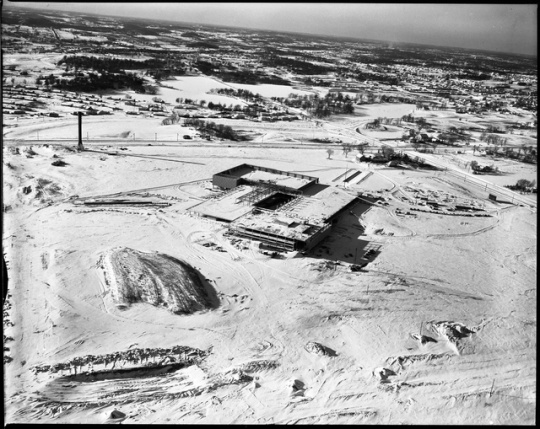
Aerial, Southdale under construction, Edina
Holding Location
Articles
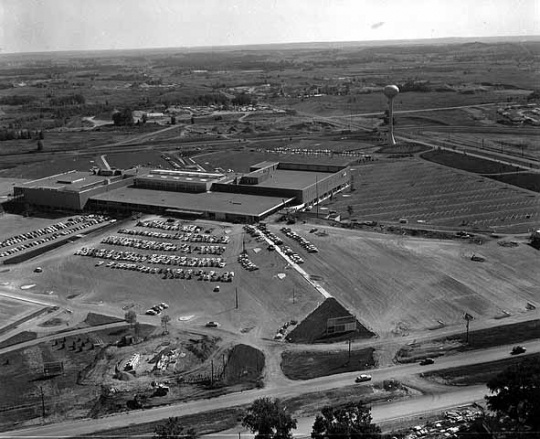
Southdale, Edina
Southdale, Edina. Photographer: Minneapolis Star Journal Tribune, 8/14/1956.
All rights reserved
Holding Location
Articles
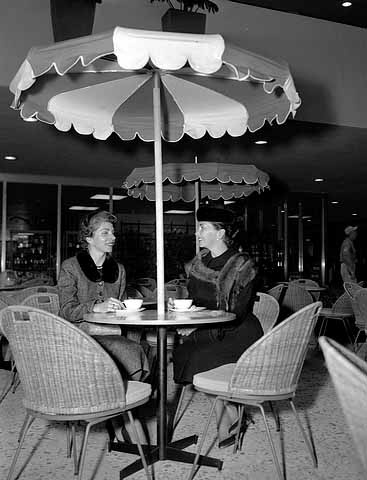
Southdale, view of courtyard restaurant, Edina
Southdale, view of courtyard restaurant, Edina. Photographer: Minneapolis Star Journal Tribune, 10/4/1956.
All rights reserved
Holding Location
Articles
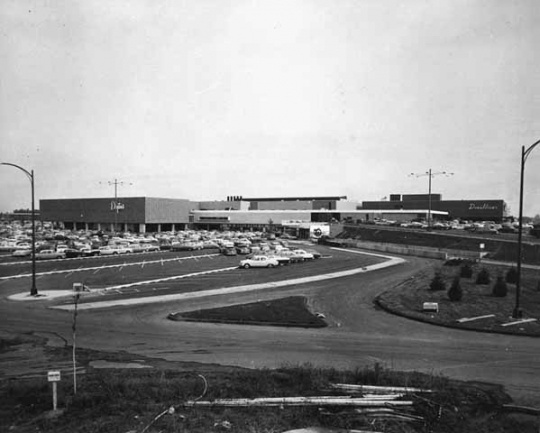
Southdale Center, Seventieth and France, Edina.
Holding Location
Articles
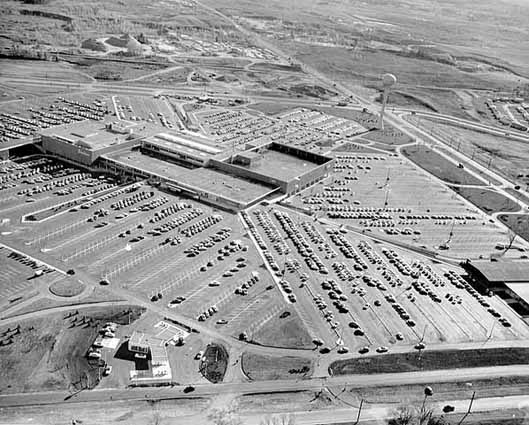
Southdale Center, Seventieth and France, Edina
Holding Location
Articles
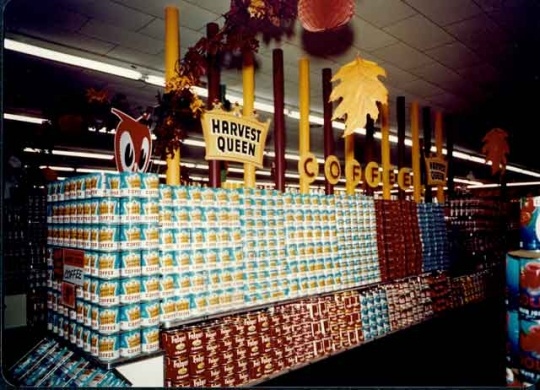
Coffee display at the Red Owl Store, Southdale Mall, Edina
Holding Location
Articles
More Information
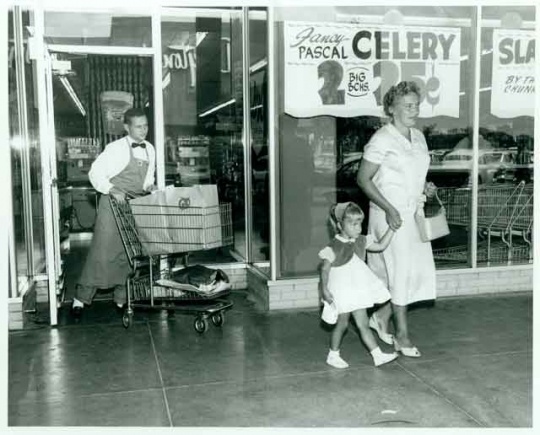
Employee Dick Liecting pushing a grocery cart for two shoppers at the Red Owl Store, Southdale Mall, Edina
Holding Location
Articles
More Information
Related Articles
Turning Point
In 1952 Donald Dayton and Victor Gruen unveil their plans for Southdale, the nation's first enclosed, weatherproofed mall.
Chronology
1952
1956
1965
Bibliography
Edgerton, Martin. "From Southdale to the Mall of America : Urban Models for Cities of Our Time." Hennepin History 51, no. 3 (1992): 4–14.
Gladwell, Malcom. "The Terrazzo Jungle." New Yorker, March 15, 2004.
Southdale Regional Shopping Center. N.p.: [Minnesota: 196?].
Related Resources
Primary
Adolph F. Meyer papers, 1901–1971
Manuscript Collection, Minnesota Historical Society, St. Paul
http://www2.mnhs.org/library/findaids/00065.xml
Descriptions: Project files and related papers of a hydraulic engineer and inventor who for many years maintained a consulting practice in Minneapolis (Minn.). The files include correspondence and memoranda, notes and calculations, project reports, maps, mechanical drawings, photographs, and hydrological, meteorological, and other data.
Etnier, Ralph J. Natural gas operates world's largest heat pump. Minneapolis, Minn.: Minneapolis Gas Company, Suburban Division, 1956.
Southdale Regional Shopping Center, [Minnesota: s.n., 196-?]
Southdale Shopping Center development plans, 1953–1956.
Manuscript Collection, Minnesota Historical Society, St. Paul
Description: Development plans for the Southdale Shopping Center in the city of Edina, including site plans and profiles, site details, utilities, building plans and profiles, a street improvement plan, a master plan for realty development in the Southdale area, and site plan for a proposed medical center.
Steven A. Schluter photograph collection, c.1970–1986
Sound and Visual Collection, Minnesota Historical Society, St. Paul
Description: Contact sheets and photoprints printed from original 35mm negatives in Minnesota Historical Society collections.
Secondary
"Birth, death and shopping." The Economist, December 19, 2007. http://www.economist.com/node/10278717.
Gruen, Victor. Shopping Towns USA: The Planning of Shopping Centers. New York: Reinhold Pub. Corp., 1960.
Hardwick, Jeffrey M. Mall Maker: Victor Gruen, Architect of an American Dream. Philadelphia: University of Pennsylvania Press, 2004.
Kowinski, William Severini. The malling of America: an inside look at the great consumer paradise. New York: W. Morrow, c1985.
Meier, Peg. "The shopping center that spawned a community." Mpls. St. Paul Magazine, August 1981, 67.
Murray, Frank. "Wright Asks City to Seek 'Truth, Not Just Facts'." Minneapolis Star, November 28, 1956.
Red Owl Store photograph collection, c.1956–1963
Sound and Visual Collection, Minnesota Historical Society, St. Paul
Description: The collection includes both commercial prints depicting grocery displays and various snapshots of employees and shoppers at the Red Owl Store in the Southdale Shopping Center in Edina, Minnesota.
Victor Gruen Associates, architecture, planning, engineering.[ Los Angeles], CA: The Associates, 1966.









